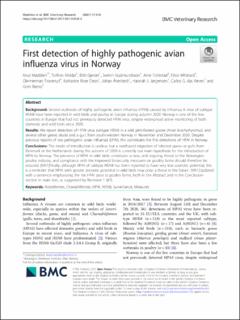| dc.contributor.author | Madslien, Knut Ivar Engesæter | |
| dc.contributor.author | Moldal, Torfinn | |
| dc.contributor.author | Gjerset, Britt | |
| dc.contributor.author | Gudmundsson, Sveinn H | |
| dc.contributor.author | Follestad, Arne | |
| dc.contributor.author | Whittard, Elliot | |
| dc.contributor.author | Tronerud, Ole-Herman | |
| dc.contributor.author | Dean, Katharine Rose | |
| dc.contributor.author | Åkerstedt, Johan | |
| dc.contributor.author | Jørgensen, Hannah Joan | |
| dc.contributor.author | das Neves, Carlos Gonçalo | |
| dc.contributor.author | Rømo, Grim | |
| dc.coverage.spatial | Europe, Norway | en_US |
| dc.date.accessioned | 2021-06-17T07:35:15Z | |
| dc.date.available | 2021-06-17T07:35:15Z | |
| dc.date.created | 2021-06-16T10:23:06Z | |
| dc.date.issued | 2021 | |
| dc.identifier.issn | 1746-6148 | |
| dc.identifier.uri | https://hdl.handle.net/11250/2759884 | |
| dc.description.abstract | Background: Several outbreaks of highly pathogenic avian influenza (HPAI) caused by influenza A virus of subtype H5N8 have been reported in wild birds and poultry in Europe during autumn 2020. Norway is one of the few countries in Europe that had not previously detected HPAI virus, despite widespread active monitoring of both domestic and wild birds since 2005. Results: We report detection of HPAI virus subtype H5N8 in a wild pink-footed goose (Anser brachyrhynchus), and several other geese, ducks and a gull, from south-western Norway in November and December 2020. Despite previous reports of low pathogenic avian influenza (LPAI), this constitutes the first detections of HPAI in Norway. Conclusions: The mode of introduction is unclear, but a northward migration of infected geese or gulls from Denmark or the Netherlands during the autumn of 2020 is currently our main hypothesis for the introduction of HPAI to Norway. The presence of HPAI in wild birds constitutes a new, and ongoing, threat to the Norwegian poultry industry, and compliance with the improved biosecurity measures on poultry farms should therefore be ensured. [MK1]Finally, although HPAI of subtype H5N8 has been reported to have very low zoonotic potential, this is a reminder that HPAI with greater zoonotic potential in wild birds may pose a threat in the future. [MK1]Updated with a sentence emphasizing the risk HPAI pose to poultry farms, both in the Abstract and in the Conclusionsection in main text, as suggested by Reviewer 1 (#7). nseriformes, Charadriiformes, HPAI, H5N8, Surveillance, Measures | en_US |
| dc.language.iso | eng | en_US |
| dc.rights | Navngivelse 4.0 Internasjonal | * |
| dc.rights.uri | http://creativecommons.org/licenses/by/4.0/deed.no | * |
| dc.subject | Anseriformes | en_US |
| dc.subject | Charadriiformes | en_US |
| dc.subject | HPAI | en_US |
| dc.subject | H5N8 | en_US |
| dc.subject | Surveillance | en_US |
| dc.subject | Measures | en_US |
| dc.title | First detection of highly pathogenic avian influenza virus in Norway | en_US |
| dc.type | Peer reviewed | en_US |
| dc.type | Journal article | en_US |
| dc.description.version | publishedVersion | en_US |
| dc.rights.holder | ©The Author(s). 2021 | en_US |
| dc.subject.nsi | VDP::Landbruks- og Fiskerifag: 900::Klinisk veterinærmedisinske fag: 950 | en_US |
| dc.source.volume | 17 | en_US |
| dc.source.journal | BMC Veterinary Research | en_US |
| dc.identifier.doi | 10.1186/s12917-021-02928-4 | |
| dc.identifier.cristin | 1916061 | |
| dc.relation.project | Andre: UK Department for Environment, Food & Rural Affairs (DEFRA) | en_US |
| dc.relation.project | Andre: Scottish and Welsh administrations, Grant number SV3006 | en_US |
| dc.source.articlenumber | 218 | en_US |
| cristin.ispublished | true | |
| cristin.fulltext | original | |
| cristin.qualitycode | 2 | |

